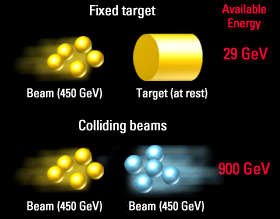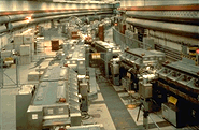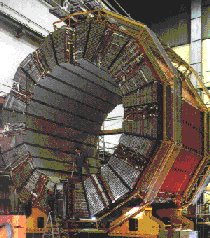


Example of available energy for fixed target and collider configurations
The ISR (Intersecting Storage Rings)
A modern particle detector: the ALEPH hadronic calorimeter
The Accelerator Era
Colliders
Soon after starting out on the
great accelerator adventure, physicists realised that when an accelerated
beam of particles hits a stationary target, most of the energy is wasted
in the recoil of the target and only a small fraction is left for the
real purpose of studying particles and their interactions. If, instead,
two particle beams collided head-on with each other, no recoil energy
would be wasted, and all the energy would be available for the experiment
- think how much more devastating is the head-on collision between two
speeding cars than the collision when one of the cars is stationary.
While other laboratories concentrated on colliding beams of electrons, CERN worked on protons. The idea was to take proton beams from the PS, feed them into the two interconnected rings of a new machine and then force them to collide. The 31+31 GeV Intersecting Storage Rings (ISR), after overcoming many technological challenges, produced the first proton-proton collision in 1971.
Meanwhile, also particle detectors had to undergo major developments, and the old bubble chamber was replaced by faster and more modern techniques, able to record the increasing number and size of interactions. But a major step had still to come: in the 1980s, made possible by the cooling techniques, available antimatter entered the game, gaining soon a predominant position.
Two parallel ways opened up to further developments of accelerators; in one, physicists would keep using antiparticles as a tool for further inquiring on the fundamental constituents of matter, going towards the high energy frontier of our knowledge. In the other, antiparticles would became the main subject of study, decelerated to low energy and isolated to explore the properties of antimatter.


